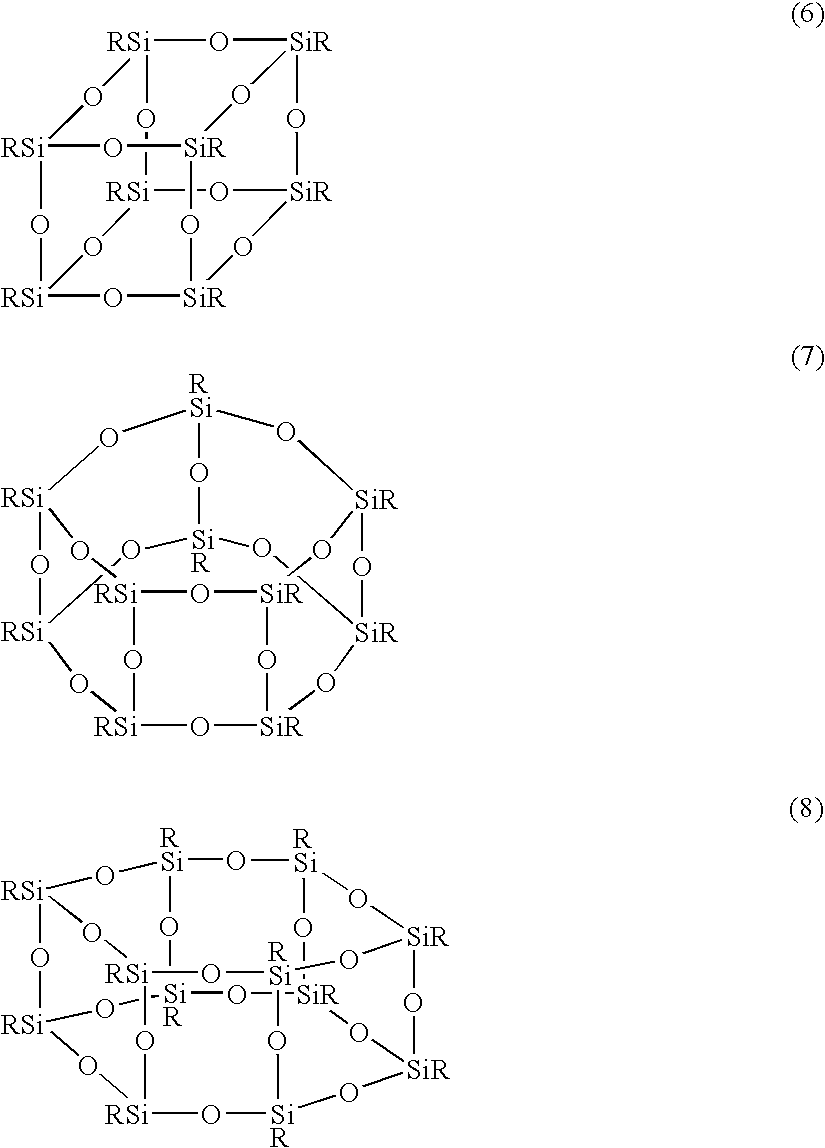Silica-Containing Silicone Resin Composition and Its Molded Product
a silicone resin and composition technology, applied in the field of silicone-containing silicone resin composition and three-dimensional crosslinked resin articles, can solve the problems of limited use, poor impact resistance and easy fracture, and the heat resistance and coefficient of linear thermal expansion of transparent plastics are markedly inferior to inorganic glasses
- Summary
- Abstract
- Description
- Claims
- Application Information
AI Technical Summary
Benefits of technology
Problems solved by technology
Method used
Image
Examples
synthesis example 1
[0070] In a reaction vessel equipped with a stirrer, a dropping funnel, and a thermometer, 40 ml of 2-propanol (IPA) as a solvent and a 5% aqueous solution of tetramethylammonium hydroxide (aqueous solution of TMAH) as a basic catalyst were introduced. In the dropping funnel, 15 ml of IPA and 12.69 g of 3-methacryloyloxypropyltrimethoxysilane (available as SZ-6030 from Dow Corning Toray Silicone Co., Ltd.) were placed. The IPA solution of 3-methacryloyloxypropyltnimethoxysilane was added in drops over a period of 30 minutes at room temperature while stirring the reaction vessel. Upon completion of the addition of 3-methacryloyloxypropyltrimethoxysilane, the reaction mixture was stirred for 2 hours without heating. After 2-hour stirring, the solvent was removed under reduced pressure and the residue was dissolved in 50 ml of toluene. The reaction solution washed with a saturated aqueous solution of sodium chloride until the solution became neutral, and was dehydrated over anhydrous m...
example 1
[0073] In a reaction vessel equipped with a stirrer, a thermometer, and a condenser, 150 parts by weight of isopropanol dispersed colloidal silica sol (particle size of 10 to 20 nm, solid content of 30 wt %, water of 0.5 wt %, and available as IPA-ST from NISSAN CHEMICAL INDUSTRIES, LTD.) (silica solid content of 30 parts by weight) as silica fine particles and 7.2 parts by weight of 3-methacryloyloxypropyltrimethoxysilane (available as SZ-6030 from Dow Corning Toray Silicone Co., Ltd.) as silane compounds were introduced and the mixture was heated gradually while stirring. The mixture was further heated for 5 hours after the temperature of the reaction solution reduced 68° C., and then the treatment of a silica fine particle was performed. The resultant was mixed with 55 parts by weight of a silicone resin composition (25 parts by weight of cage type silicone resin having a methacryloyl group on each of silicone atoms, which was obtained in Synthesis Example 1 and 75 parts by weigh...
examples 2 to 6
[0075] A resin molded article was obtained in the same matter as in example 1 except that a mixing composition was changed to the ratio shown in Table 1. The physical properties of the obtained molded articles are shown in Table 2.
PUM
| Property | Measurement | Unit |
|---|---|---|
| particle size | aaaaa | aaaaa |
| specific gravity | aaaaa | aaaaa |
| glass transition temperature | aaaaa | aaaaa |
Abstract
Description
Claims
Application Information
 Login to View More
Login to View More - R&D
- Intellectual Property
- Life Sciences
- Materials
- Tech Scout
- Unparalleled Data Quality
- Higher Quality Content
- 60% Fewer Hallucinations
Browse by: Latest US Patents, China's latest patents, Technical Efficacy Thesaurus, Application Domain, Technology Topic, Popular Technical Reports.
© 2025 PatSnap. All rights reserved.Legal|Privacy policy|Modern Slavery Act Transparency Statement|Sitemap|About US| Contact US: help@patsnap.com



